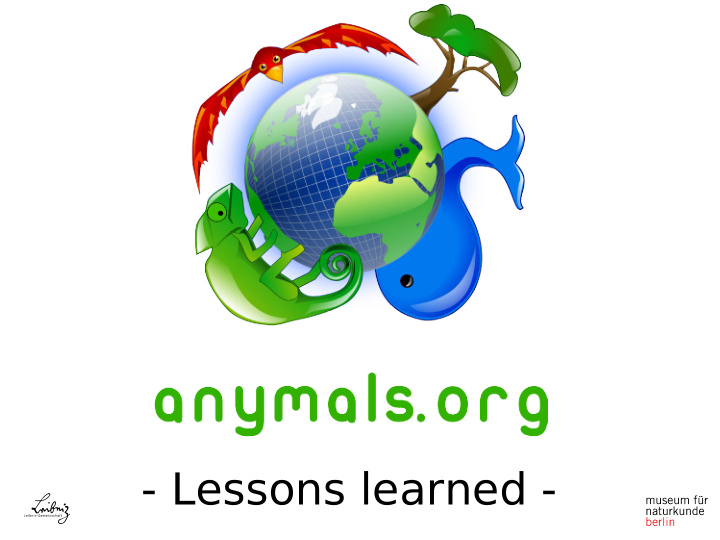



- Lessons learned -
What is ? • Project of Museum für Naturkunde Berlin + AWI + University Erlangen • Originally for scientific whale watching 1 • Citizen Science project of the German GBIF node (GBIF-D) • Mobile application for retrieving, recording and sharing biodiversity observations • International, multilingual, free of charge • Existing information from GBIF, CoL, Wikipedia • Usable online and offline • Android, iOS, FirefoxOS
What is ? Online platform www.anymals.org for • Presenting the data on maps, • Commenting and discussing determinations and observations of others, • Organizing groups, • Building customized forms, • Data entry and editing. • etc.
chronicles • 2011: • Search for data in your surrounding and get information • Enter species observations • Native Android app • 2012 • Citizen science groups • interface to Open Nature Guides (identification keys) • Citizen Science data mobilized for GBIF • Beginner's mode vs. expert mode • Improved user interface
chronicles • 2013 • Customizable forms • Interface to Scratchpads • First HTML5 based version (more OS independent) • New user interface • 2014 • Generic framework for building specialized apps on the code basis of anymals + plants within hours or few days (i.e. Comber, Terra Explora, Walog, Pilze, BeachExplorer, anylog (experts only!)) more information on https://www.anymals.org/?view=customapps
User / Download Statistics installations ~ 174,000 2012 2014 2013 current users ~ 28,000
Lessons learned • “ being a free app doesn’t mean it advertises itself ” • PR, campaigns and events are needed! • “ sometimes less is more ” A lot of different demands can’t be accommodated in one app • Laymen => information, learning, fun, awareness • Experts => recording, taxonomy, efficiency, flexibility • Projects => organization, mobilization, interfaces, specialization • Technical demands • => offline, but no large files • => many operating systems and different devices
Lessons learned • “ sometimes less is more ” • the user interface is the most important to make a user decide to keep the app or not
Lessons learned • “ sometimes less is more ” • the user interface is the most important to make a user decide to keep the app or not
Lessons learned
Lessons learned
Lessons learned • “ sometimes less is more ” • the user interface is the most important to make a user decide to keep the app or not • “ mobile species identification needs high-quality keys ” • “ everyone builds mobile apps ” • Let’s join efforts !
Future plans • Optimization of the generic app framework (available in 2015 at www.mobilebiodiversity.com) • More derivate applications • Own Cloud service for images • Data quality data for nature conservation (project draft work in progress) • As always: New collaborations are welcome!
References • Bombosch A., Zitterbart DP., van Opzeeland IC., Frickenhaus S., Wisz MS, Boebel O. Predictive habitat modelling of humpback (Megaptera novaeangliae) and antarctic minke (Balaenoptera bonaerensis) Whales in the southern ocean as a planning tool for seismic surveys Deep Sea Research I, Volume 91, Sept. 2014, Pages 101– 114 , doi: 10.1016/j.dsr.2014.05.017 • http://www.anymals.org – Customizable forms https://www.anymals.org/?view=/sightingforms/ – Get your own mobile app https://www.anymals.org/?view=customapps/ • http://offene-naturfuehrer.de (“Open Nature Guides”) • http://scratchpads.eu/
Thanks for your attention!
Recommend
More recommend